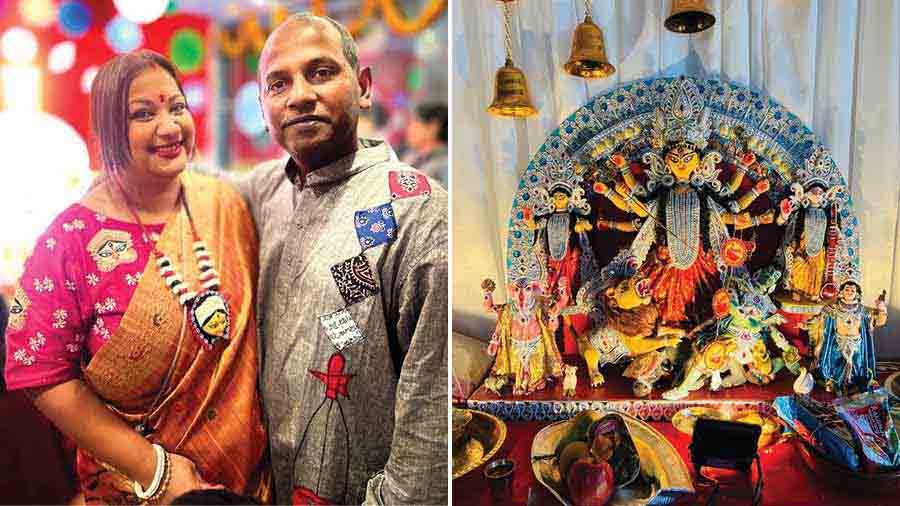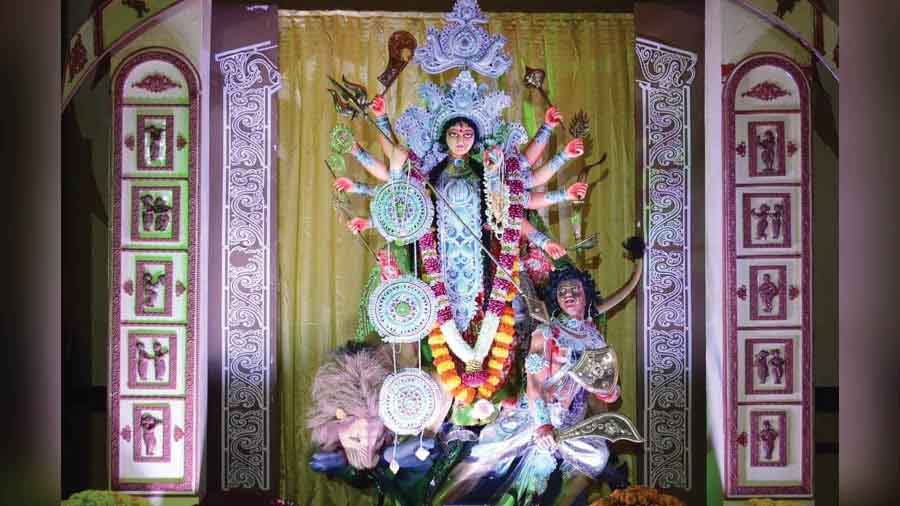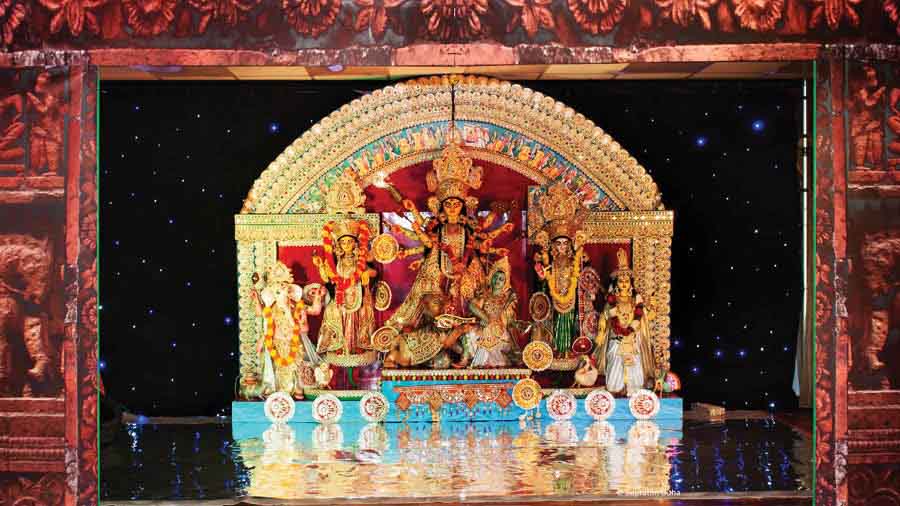About a 45-minute drive from Amsterdam lies Lelystad, a city that is also the largest municipality (in terms of area) in the Netherlands. An increasingly popular choice as a place of residence for immigrant families, Lelystad is traditionally known for its historic ships, fishing harbours and fashion. However, over the last three years, it is also gaining recognition as the site of the biggest barir Durga Puja in the Netherlands, hosted at the Roybari by Pallab and Rumki Roy. Having started in 2021, the Puja entered its third year this time, with more than 900 people attending across five days. “Family, friends and lots of fun” is how the Roys describe celebrating Bengalis’ signature festival more than 7,600km away from Kolkata.
With a Durga made of fibre imported from Kumartuli, the Roys organise their Puja as a hyperproductive team of two, with assistance from their friends. While the main Puja takes place inside the premises of the Roy residence, their backyard is large enough to accommodate over 300 guests at once. Tents, equipped with heaters, are erected to make attendees feel comfortable, as everything from music to sumptuous Indian snacks to a live bar counter evokes a carnivalesque atmosphere. “This year we did a Vijaya Dashami procession for the first time. We took permission from our neighbours and they obliged,” says Pallab, 45, who works in the satellite industry. “We had everything from the bhashan naach to the dhaak,” adds Rumki, 43, a homemaker and owner of a small business which she runs from her house.
Two purohits, bhog, fish fry, song and dance, and much more
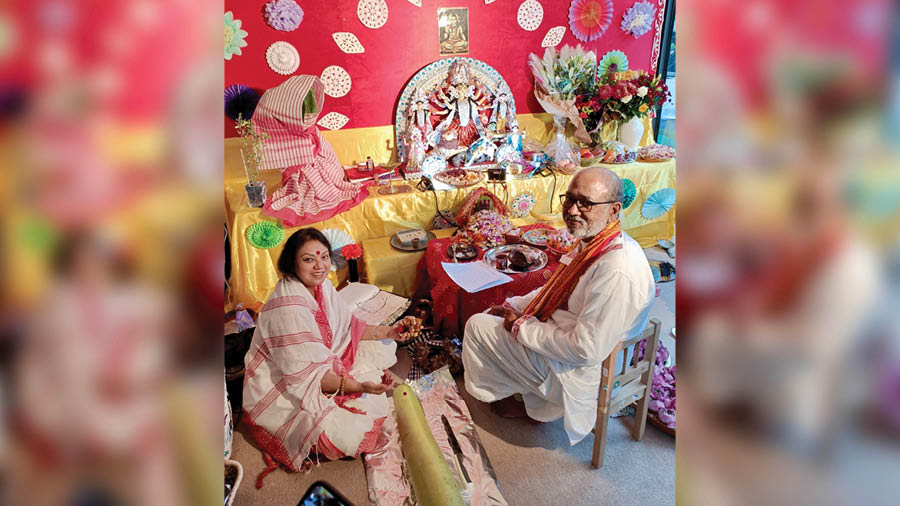
The purohit couple responsible for conducting the Roybarir puja
The Roys began their Durga Puja with the idea of having a “homely Puja” that gets the Bengali and Indian community more involved. Even after three years, they fund the Puja from their own pockets, spending anywhere between €5,000 and €7,000 every year following a much larger initial investment. “We had to buy the idol, the utensils, the carpet, among other things, when we began. After that, we mostly end up reusing things whenever we can,” says Pallab, who clarifies that visitors to Roybari are discouraged from donating more than €2 as pronami. While others may not chip in with funds, they do contribute a lot in terms of time and energy. “Our friends help us manage the Puja in various ways. Someone is in charge of the cooking, overseeing all the meals for the bhog that the women pre-cook at home and bring to our place. A Nepali friend of ours had a live momo counter this time. There was also Maharashtrian pav bhaji to go with Bengali favourites like chingri and ilish, fish fry, mutton, phuchka and more,” narrates Pallab, with Rumki adding how “many of us came together and made phuchka as late as half-past two in the morning”.
A couple of purohits (quite literally!) from Belgium come over every year to conduct the Roybarir Puja, with the husband presiding over the day-to-day rituals and the wife taking charge of the Kumari Puja alongside translating some of the mantras into Hindi and English. A cultural programme involving song, dance and recitation is a fixture on the Puja weekend, when chats and friendly banter last late into the night. While most visitors at the Puja are Bengalis and/or Indians, Dutch locals also drop in from time to time. “Many bystanders are fascinated to find out what happens,” say the Roys, who insist on not collecting any entrance fees. This year, however, they formalised the visitor registration process with the help of an app called Roybari. Not only did the app help the Roys keep track of all those planning to turn up at their Puja, it also enabled them to design a game. “We asked visitors to register their names along with an NGO of their choice. Every visitor had the opportunity to accumulate socialisation points by exchanging messages and networking with other guests. The points were eventually converted into cash, which the visitors donated to the NGOs they had nominated,” explains Pallab. One of the beneficiaries of this arrangement was Bhalo Pahaar, an NGO in Bengal’s Midnapore district.
‘This was and will always be a barir puja at heart’
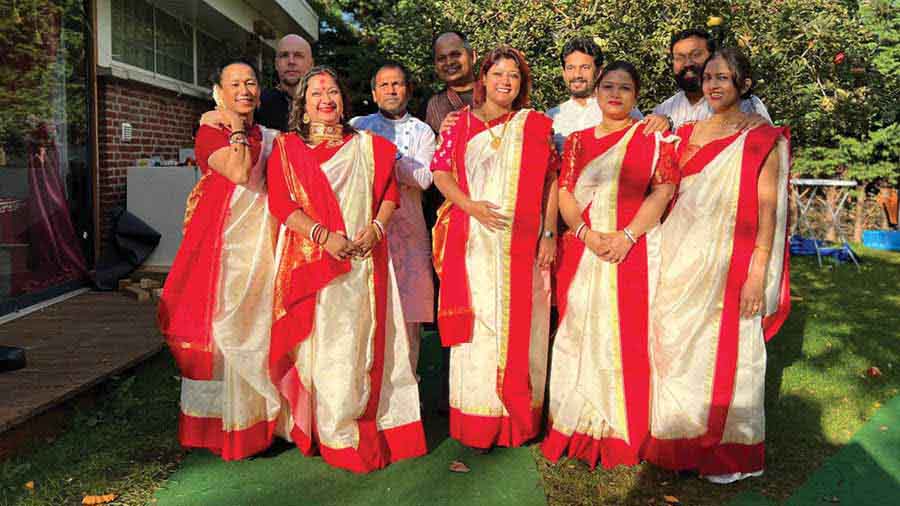
The Roys describe their Puja as a team effort, with support from their friends and neighbours
The Roys themselves had moved to the Netherlands from Kolkata in 2008, a year after getting married. “We spoke for the first time over a mock customer care call,” recalls Pallab, who was suave enough to secure Rumki’s personal number following their initial exchange. The move to a different country and continent happened because of a job opportunity for Pallab. Initially, the Roys did not find it easy to settle into their Dutch lifestyle, with “shops closing by 5pm and not opening at all on Sundays”. It was the first time either of them had gone out of India and there was not much Indian presence to speak of in their neighbourhood either. Slowly and surely that started changing, with more Indian families as well as some Bengali ones moving in. The couple who now have two children — 13-year-old Ankit and 8-year-old Adrika — try coming back to Kolkata at least once or twice every year. “Even though a part of our hearts will always be in Kolkata and Bengal (the Roys used to stay in Dum Dum before relocating to Madhyamgram), we really like it here in Lelystad. It’s very peaceful to live here,” say the Roys.
Going forward, the Roys want to make slight adjustments to their Durga Puja. “For starters, we’d like to make an idol with local clay and with the help of local artisans. We also want to have a bigger stage, expand our cultural events and provide more seamless parking facilities,” says Pallab, all the while assuring My Kolkata that the essence of Roybarir Puja will remain the same: “This was and will always be a barir puja at heart. That’s why we started it. That’s why we’ll keep it going.”
